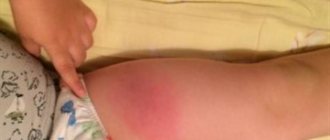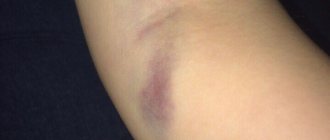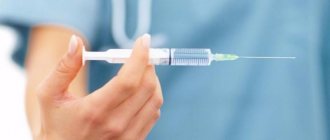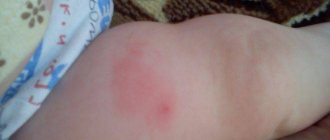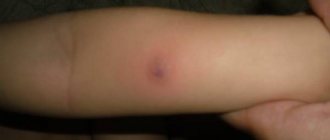How to remove pain and inflammation from an abscess after an injection
The occurrence of an abscess after an injection is not considered a rare occurrence. This is a complication that requires treatment, otherwise the process can lead to blood poisoning. Injections in medicine for various diseases are prescribed quite often, so this topic will always be relevant. You should consider what symptoms may indicate to a person that an abscess has occurred, how much an intramuscular injection at home costs, and what is recommended to be done to suppress the pain.
Departure is paid separately - from 350 rubles
Call any time of the day:
Reasons for the development of abscesses after an injection
Any intramuscular injection is an invasive procedure. Such an intervention violates the integrity of the skin and triggers a whole chain of pathological changes. As a rule, the cause of an abscess is incorrect administration of injections in violation of the rules of asepsis and antisepsis. Often such complications occur if the injection was given at home.
Predisposing factors for the development of an abscess are decreased immunity and a sharp weakening of the body.
The correct way to administer the injection is to insert a needle into the upper outer quadrant of the buttock. It is permissible to inject the medicine into the muscle layer of the shoulder or thigh. If the syringe needle enters a large blood vessel, hemorrhage occurs into the soft tissue, which can lead to the development of an abscess. A number of drugs can have an irritating effect on tissue; when administered not into the muscle, but into the subcutaneous fat, it can also lead to the formation of an abscess.
If the wound at the injection site was scratched, this could serve as an entry point for infection and cause a suppurative process.
What symptoms do you see a surgeon for:
- Presence of hernial protrusion
- Daggering pains in the abdomen
- Bloating
- Pain in the right hypochondrium
- Bitterness in the mouth
- Nausea
- Presence of neoplasms on the skin
- Swelling and redness of the skin
- Bone fractures and bruises
- Wounds of any location
- Vomit
- Enlarged and painful lymph nodes
Causes of inflammation of the injection site
Injections in medicine are considered a regular procedure due to the fact that the medicine bypasses the digestive tract and acts as quickly as possible, entering the blood. The appearance of an abscess after injections is considered a separate complication and requires a certain type of treatment. When diagnosing, it is necessary to examine the affected area and distinguish an abscess from phlegmon. These processes are quite similar, with the only difference that phlegmon has no boundaries and a capsule that connects to healthy tissue.
The occurrence of an abscess after an injection is possible for the following reasons:
- an incorrect injection;
- non-compliance with sanitary and hygienic standards;
- puncture of a blood vessel;
- bedsores;
- allergic reactions;
- failure to comply with hygiene rules;
- excessive number of injections of different contents;
- severe chronic diseases.
To avoid accidental problems, it is recommended to monitor all possible violations of medical personnel when administering injections and demand compliance with rules and regulations. This will help the patient protect himself from serious consequences and complications. When calling a nurse to your home, injections should be checked according to the expiration date and the integrity of the packaging.
Another mistake made by medical personnel is the incorrect use of the drug. Some medications are intended for a specific type of injection (intravenous, intramuscular). If an injection is administered incorrectly to a patient, problems may arise, leading to an abscess.
It is worth remembering that doctors do not recommend giving injections yourself. Incorrect technique due to inconvenience will lead to skin inflammation.
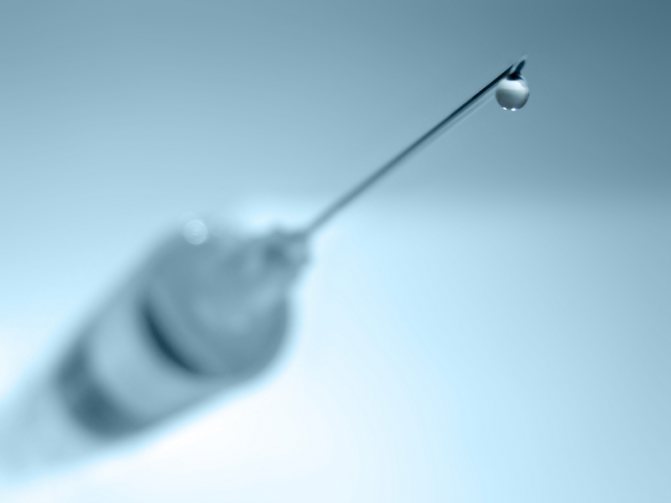
Pathogenesis
An abscess after injection is a complication that is caused by the formation of a purulent inflammatory infiltrate in the cavity in the soft tissue layers, most often as a result of infection. The cavity is formed by the pyogenic membrane, and on the inner wall there is a lining layer of granulocytes, which prevents the pus from “resolving.”
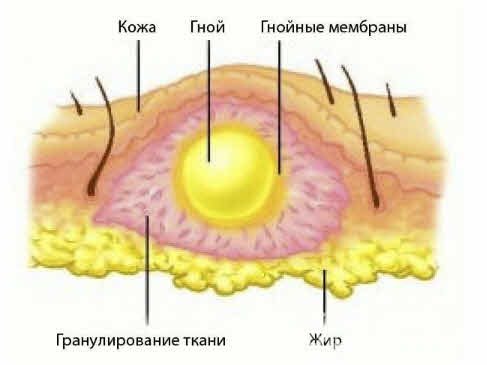
Abscess structure
In the pathogenesis of complications after injections, the physicochemical properties of the administered drugs, the frequency and duration of their exposure, and compliance with the recommendations of the method of administration are of greatest importance. Tissue damage is chemical or occurs during repeated administration of drugs in one place, disrupting tissue trophism and promoting the development of pathogenic microflora, and is also possible as a result of an accidental needle entering a vessel or a complication of infusion therapy, causing the subsequent occurrence of a hematoma in which microorganisms can begin to multiply.
At the stage of infiltration, cell damage and death stimulate the release of many lysosomal enzymes into the extracellular space, changing the metabolism in the lesion - slowing it down in the area of necrosis and increasing it in adjacent areas. This is expressed in an increase in oxygen consumption and various nutrients, the development of acidosis and the accumulation of under-oxidized products such as lactic, pyruvic acid, etc. Due to increased blood flow, dilation of blood vessels and increased permeability, the release of leukocytes and macrophages occurs. Swelling is caused by a local influx of fluid, and pain is caused by pressure on the nerve endings. Abscess formation leads to the formation of pus, consisting of dead tissue and dead cells of the immune system, which is located in the center of the inflammation and is not eliminated until there is an opportunity for its outflow, for example, by drainage.
Symptoms and signs of an abscess
The first signs of an abscess can be noticed at the very beginning of infection. A compaction appears that has no contours, and then painful sensations occur with swelling and the formation of a movable capsule.
The symptoms of an abscess depend on the severity of the situation. If the infection is deep, the person will feel severe pain when pressing on this place. In such a situation, it will be problematic to clearly see the signs of an abscess. The main symptoms of this complication are considered to be:
- swollen injection site;
- irritation and redness;
- pain when pressing;
- the presence of liquid in the tissue;
- increased body temperature at the injection site;
- in difficult situations, fistula formation is possible.
Departure is paid separately - from 350 rubles
Call any time of the day:
Doctors also identify several common signs of an abscess after an injection:
- high body temperature;
- severe weakness;
- rapid onset of fatigue;
- sweating;
- irritability;
- refusal to eat.

It is worth understanding that the occurrence of an abscess is a dangerous situation, the treatment of which cannot be delayed even for a few days. When infected, the seal produces many harmful bacteria that pose a critical threat to health. If the membrane containing the liquid breaks, the bacteria directly enter the bloodstream and cause infection of the entire body.
Symptoms
Post-injection abscesses are characterized by a gradual development of the clinical picture, which is most pronounced at approximately 7–14 days and includes local and systemic manifestations:
- the formation of a painful infiltrate, which initially worries only during movements or palpation, and then at rest, while the pain is initially aching and then changes to throbbing and its intensity increases, in addition, hemorrhages at the injection site are possible - if the integrity of the blood vessels during manipulation was mechanically damaged;
- general intoxication is mild at first, causing low-grade fever and minor malaise; later, pain intensifies, hectic debilitating fever develops, general weakness increases, headaches and nausea appear.
What does an abscess look like after an injection?
At first, a formation with an infiltrate does not have clear boundaries, and if the inflammatory focus is located in the gluteus maximus muscle or under it, then it is extremely difficult to detect the infiltrate during palpation. When pain and fever increase, the infiltrate becomes denser with local signs of hyperemia. If an abscess is formed, then softening can be detected in the center - tissue necrosis, and the hyperemia becomes bluish in color.
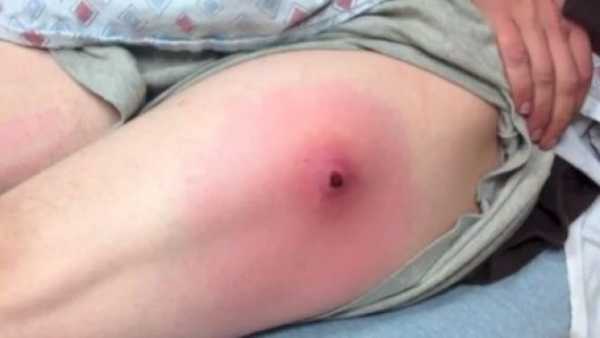
Appearance of an abscess
When the formation of an abscess occurs on the buttock in the deep layers under the bundles of the gluteus maximus muscle, signs of hyperemia on the skin may be absent, and the boundaries of the infiltrate may not be clear enough. In such cases, they focus on the timing of the disease and perform an ultrasound examination or puncture under the supervision of an ophthalmologist.
Features of the clinic of abscesses after subcutaneous administration of vaccines or serums
Local inflammatory and general reactions are a normal response of the body to the administration of immune drugs, for example, vaccines against tick-borne encephalitis , rabies vaccines prepared with formaldehyde or carbolic acid . An abscess may be suspected if the temperature rises to 38 degrees and fever for 3 days, while the amount of infiltrate increases, and antihistamine therapy and physiotherapy do not have a positive effect. Ultrasound may not be informative, since the formation may consist of many abscesses, but if they are aseptic, then the use of conservative methods is sufficient for treatment.
How to get rid of pain when an abscess occurs and diagnose it
If signs of an abscess are detected, the first step is to seek medical help. The initial stage is diagnosis of the complication. To do this, you need to pass the following tests:
- blood analysis;
- Analysis of urine;
- bacteriological cultures;
- culture for microflora;
- ultrasound examination (for chronic pathology).
If there are obvious complications, an additional tomography may be prescribed by the doctor's decision. When examining a patient, the specialist is obliged to check the lymph nodes that are in close proximity to the site of inflammation. Their increased size is considered normal, but they should not be painful. If pain occurs, there is a possibility of lymphadenitis - a complication that indicates the spread of infection throughout the body.

Treatment and prevention of complications with abscess
Self-medication is strictly not recommended. Any inflammation is considered dangerous to human health, and when treating an abscess it is necessary to consult a doctor. In most cases, conservative treatment is used without complications. The initial step before contacting a medical facility is the application of cold compresses, which should affect the resorption of the purulent seal.
If this method does not bring improvement, but the condition of the wound does not worsen, cold compresses are replaced with warm ones (a heating pad). Since infection is caused by various bacteria, any doctor is required to prescribe antibacterial drugs to the patient. In case of complications or a large volume of affected skin, surgical intervention with opening of the wound is used.
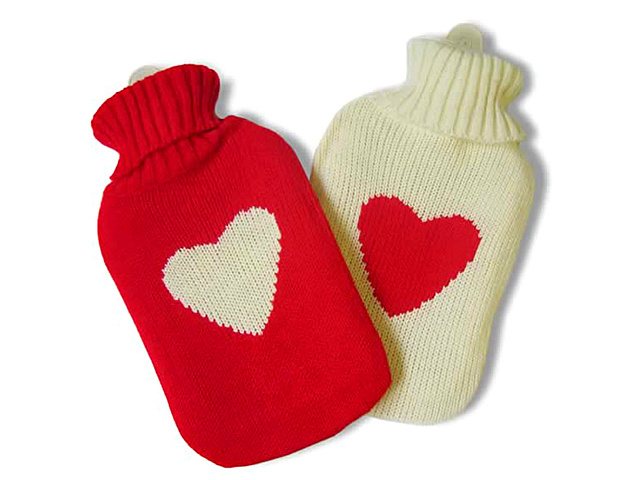
Antibacterial agents can be tablets, ointments or injections. In order to prescribe medication, test cultures of the purulent abscess mass must be taken. Based on the results obtained and taking into account the individual perception of the components of the drug, the attending physician prescribes a comprehensive treatment for the patient.
The advantage of using an ointment is that it has an effect only in the area of inflammation and does not enter the bloodstream. It is worth noting that if you have diabetes, it is necessary to take additional medications that will regulate the metabolism in the body.
For injections, the best option would be to call a nurse, having previously specified the cost of injections at home. You should not try to give injections yourself; it is better to entrust your health to a medical professional who has experience in administering injections. Topical medications can also help treat abscesses. Any anti-inflammatory ointments will eventually relieve swelling and stop the process of infection of healthy tissue.
How to treat an abscess
The abscess is removed by a surgeon. If you do not seek medical help in a timely manner, this can lead to even more serious consequences for the patient.
- If the inflammatory process is infiltrative and non-purulent, conservative treatment is used. Physiotherapy, absorbable medications, and warm compresses are prescribed. It is recommended to lubricate the injection site with an alcohol solution of iodine.
- If pus begins to form at the site of inflammation, the doctor at our clinic will perform a puncture, remove the accumulated pus and rinse the cavity.
- If the abscess is deep, surgical treatment is performed. An incision is made at the site of the abscess, the cavity is washed and drained.
- In case of an extensive process and symptoms of general intoxication, treatment with antibiotics, immunomodulators, and vitamins is prescribed.
Qualified specialists at our clinic treat purulent inflammatory diseases using the most effective and safe methods and medications.
Diagnostic methods in surgery:
- Doppler in surgery
- Colonoscopy
- Angiography
- CT scan
- Gastroscopy
- MRI
- Abdominal ultrasound
- X-ray
- Endoscopy
Prices:
| Code | Name of service | Prices |
| 1 | Initial appointment | 1200 |
| 2 | Repeated appointment | 900 |
| 3 | Calling a surgeon to your home | 3500 |
| 4 | Abdominal ultrasound | 2200 |
| 5 | Ultrasound of veins and vessels | 2400 |
| 6 | Doppler 2-3 trimester | 1200 |
| 7 | Rectoscopy | 1500 |
Applying a warm compress
Compress is a therapeutic multi-layer bandage. Action - causes dilation of blood vessels and increases blood circulation in tissues (analgesic and absorbable effect). Used for local inflammatory processes on the skin.
Contraindications: fever, skin lesions, allergic or pustular rashes; Do not apply a compress to skin lubricated with iodine (a burn is possible).
How to make a compress? Compress paper, cotton wool, bandage, ethyl alcohol 45% (salicylic or camphor), scissors.
Compress technique:
- wash and dry your hands;
- inspect the skin at the site where the compress was applied;
- prepare three layers of compress corresponding to the area of application: wet layer - 6-8 layers of gauze; insulating - compressed paper or polyethylene, covering the wet layer by 1.5-2 cm; insulating - cotton wool 2-3 cm thick, covering all previous layers by 1.5-2 cm;
- fold the layers: cotton wool at the bottom, then compress paper;
- dilute the alcohol with water, heat the medicinal solution by placing it in a container with water 38-39 C
- soak gauze in the solution, wring it out lightly and place it on top of the compress paper;
- Place all layers of the compress on the desired area of the body and secure with a bandage so that the compress fits tightly to the skin;
- record the time - 6-8 hours;
- wash and dry your hands;
- after 1.5-2 hours, check the correct application of the compress with your finger, without disturbing the tightness of the bandage (the gauze should be damp).
Using an ice pack
Action - cold causes a constriction of the blood vessels of the skin, reducing the sensitivity of nerve receptors. Indications: for bleeding, acute inflammatory processes in the abdominal cavity, bruises (on the first day), severe fever, in the postoperative period.
It is forbidden to freeze a bladder filled with water in the freezer, since the surface of the resulting ice conglomerate is very large, which can lead to hypothermia of the body area, and sometimes frostbite.
What do you need? Ice pack, lump ice, diapers, wooden mallet.
Performance:
- place the lump ice in the diaper and break it into small pieces (1-2 cm in size) with a wooden hammer;
- fill the bubble with ice to 1/2 of its volume and add cold (14-16 °C) water to 2/3 of its volume;
- displace the air from the bubble by pressing your hand, placing it on a hard surface (free space is provided for the water formed during the melting of the ice);
- Close the bubble tightly with the lid and, turning the stopper down, check it for leaks;
- wrap the bubble in a dry diaper and place it on the desired area of the body for 20 minutes.
The bubble can be held for a long time, but every 20 minutes you need to take a break for 10-15 minutes (as the ice melts, the water can be drained and pieces of ice added).
Source
Complications of injections in the buttock: redness and burning, allergies, forms of conjunctivitis
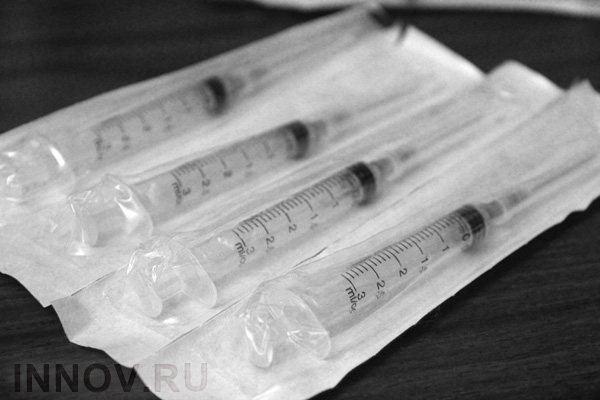
Often, the treatment of certain pathologies involves taking medications, and sometimes even injecting them, which in people with transformed reactions of the immune system can lead to the development of allergies. It is formed as a result of sensitization of the body to a certain type of allergen - a medicinal substance. Repeated use of this drug after 10-14 days or later, when immune reactions have been formed, threatens the development of various types of allergies, from anaphylactic to delayed, with a long course. Any injections and oral administration of tablets or other forms, as well as local treatment, are dangerous.
An injection in the buttock: the formation of allergies
A common option for delivering drugs into the body with the creation of high concentrations in the body is an injection into the buttock. This method of drug administration is often used in hospitals, where a quick and relatively active effect is needed. But in addition to pain at the injection sites, the risk of the formation of post-injection abscesses and hematomas, there is a danger of allergic reactions to the drug, in which injections must be stopped immediately. The difficulty is that there is still a certain supply of the drug in the muscle area, which is slowly absorbed, and the reaction is difficult to slow down. Measures are taken to eliminate allergic reactions with the introduction of desensitizing agents with simultaneous withdrawal of the medication, then the reaction quickly declines.
Source
